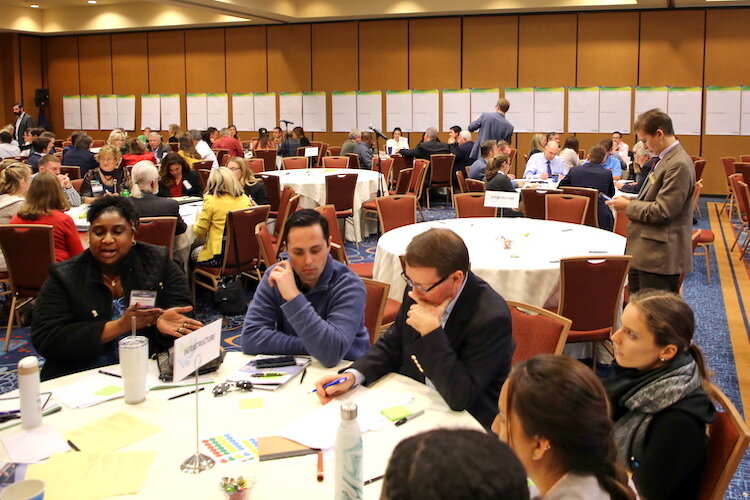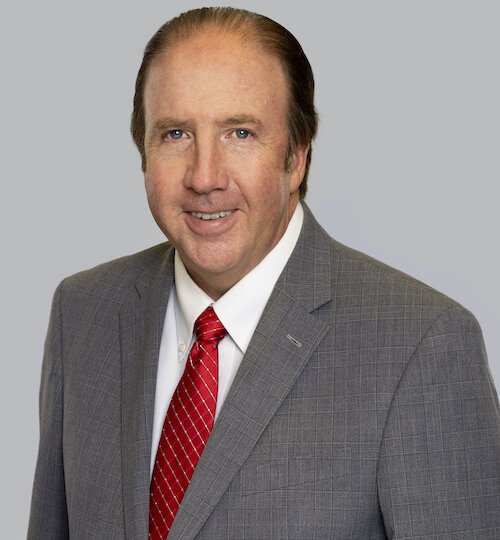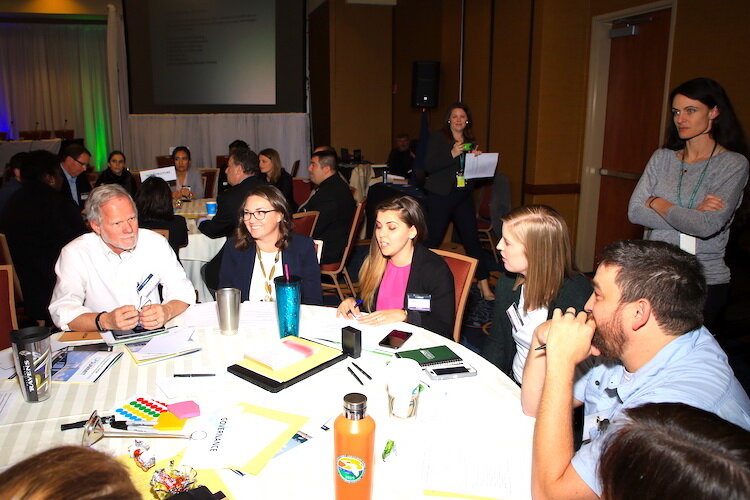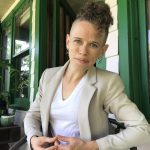Competitive grant provides green light to study solar solutions in Tampa region
The Tampa Bay Regional Planning Council (TBRPC), in partnership with USF's Patel College of Global Sustainability, and the U.S. Department of Energy, seeks to create a framework to mitigate worst-case natural disaster scenarios in the Tampa region by harnessing a form of renewable energy with bright potential: solar power.
Considering scenarios that once seemed unthinkable feels like a daily exercise in 2020 — so much so that in the wake of a globe-sweeping pandemic, nationwide civic unrest and wildfires smoldering the length of the Pacific coast — it’s understandable, this fall, that even the most storm-seasoned Floridians may on some days forget we sit neatly at the annual hurricane season halfway-mark. So far, we’ve been lucky.
But what happens when a natural disaster blacks out entire regional power grids — such as the case of lower Manhattan in the wake of Hurricane Sandy in 2012, or the devastating Hurricane Maria, which left civic infrastructure in tatters across the island of Puerto Rico in 2017? What happens when backup generators fail in hospitals; when ventilators fall silent in critical care units, when air conditioning systems cease to function in nursing homes and shelters, and when the refrigeration systems holding life-saving medicines begin to thaw during a long term power outage?
What will happen if it happens here?
In an era when climate change raises the stakes for natural disaster in coastal regions, hurricane preparedness is a forefront concern for civic leaders, first responders, and scientists who seek proactive solutions to mitigate worst-case scenarios. The Tampa Bay Regional Planning Council (TBRPC), in partnership with USF’s Patel College of Global Sustainability, and the U.S. Department of Energy, seeks to create a framework to mitigate worst-case natural disaster scenarios in the Tampa region by harnessing a form of renewable energy with bright potential: solar power.
Government grant funds study of solar solutions
The U.S. Department of Energy’s National Renewable Energy Laboratory (NREL) chose the Tampa Regional Planning Council as one among a small handful of grant recipients nationwide to study solar-powered climate resilience strategies. In partnership with local government officials in Hillsborough, Pinellas, and Manatee counties, the City of Largo, and USF’s Patel College of Global Sustainability, the Clear Sky Tampa Bay project will outline frameworks for using solar power in the wake of a natural disaster. The project team also includes a private sector partner, Solar Energy Management LLC.
Tampa Bay Regional Planning Council Executive Director Sean Sullivan says Clear Sky will explore what he calls a “FEMA-based resilience network” to reduce the costs municipalities incur to maintain critical operations in the wake of a long-lasting power outage. Possible sites could include hospitals, shelters, wastewater treatment facilities, and other locations identified by local government partners in the Clear Sky project. Implementing a strong solar network could also reduce the region’s carbon footprint, Sullivan says.
“We have over 300 days of sunshine here in the Tampa Bay region. It would be great to capture that sunshine and convert it into energy. At the same time, we need to be resilient. As we move forward with [renewable energy], we realize we live in an area that is pristine, environmentally sensitive — and also vulnerable. We live in a tropical coastal climate where we need to be prepared for hurricanes, storm surge, and other disasters,” Sullivan says.
“As this project develops, not only will we look at innovative ways to capture solar energy, but at the same time, we’ll learn to make that grid resilient. Outcomes could even be something as simple as understanding: How do we aim solar panels and elevate them to be less susceptible to storm surge? We’re looking to build a resilient framework that will help to keep power generating through a disaster with minimal interruption,” he adds.
NREL leads the Solar Energy Innovation Network (SEIN), with funding from the Department of Energy’s Solar Energy Technologies Office. Clear Sky Tampa Bay is one of only eight solar research projects in the U.S. awarded NREL grant funding.
“We selected teams that are experimenting with promising ideas to assess the use of solar power, such as for resilience in commercial-scale applications. The work of these teams will provide a blueprint and useful resources for other communities,” says Eric Lockhart, who leads the Innovation Network at NREL.
USF students research solar strategies for local municipalities
A primary goal of the Clear Sky project is to identify the economic bottom line — and potential benefits — of municipal and commercial applications of solar technology. USF students will help provide these insights.
“USF students were part of the [Tampa Bay Regional Planning Council] Resilience Summit in January and we were very pleased with their involvement. We want them to learn — but we’re also excited to learn with them, and we want their ideas and thoughts as they progress through their collegiate career. We’re asking the students to develop tools and case studies with local government partners — to outline a priority list using resilience as a baseline,” Sullivan says.
Dr. Pradeep Haldar, Adjunct Professor at Patel College, integrated the Clear Sky project into his Fall 2020 graduate course, Economics and Finance for Sustainability. Students will collaborate with Clear Sky partners in local governments who will identify “FEMA lifelines” — priority facilities requiring backup power in the event of a natural disaster. Students will then utilize tools developed by the U.S. Department of Energy and the NREL, such as REopt Lite, and conduct case studies to develop criteria that will provide an economic and technical assessment of solar-powered strategies for resilience.
“What is the cost to a hospital if its power goes down for three days after a hurricane? Even if it has backup generators, what happens if those run out of fuel? That’s an example of where we can look at the economic and technological impact of adding renewable tech like solar and batteries,” Haldar says.
Dr. Haldar has over 30 years of expertise related to solar finance. He is a Fulbright Scholar who currently serves as President at Halovation, a Tampa Bay Area-based management and technology consulting organization for energy, semiconductor, and materials technology. Haldar formerly served as Vice President of Entrepreneurship, Innovation, and Clean Energy Programs at the Colleges of Nanoscale Science and Engineering (CNSE) at the State University of New York, University at Albany, New York (now SUNY Poly). He holds his Ph.D. in Materials Engineering & Solid State Chemistry from Northeastern University and an MBA in Technology Management from Rensselaer Polytechnic Institute.
“I look at this as a really good hands-on training exercise. The goal is for students to understand how they can justify the financial implementation of those energy technologies and be able to evaluate other benefits that are not typically explored,” Haldar says.
“We want them to be trained to understand: how do you objectively look at a sustainability project from a financial aspect? Whether they’re working in a planning department in a city, or a government office, or commercial enterprise — we’re hoping they can make the case for implementing these kinds of sustainability projects,” he adds.
Patel College Dean, Dr. Govindan Parayil, says: “I am pleased to highlight the importance of the NREL-funded Clear Sky Tampa Bay project, which the Patel College of Global Sustainability has joined in partnership with the Tampa Bay Regional Planning Council. This NREL-supported project will highlight the importance of the collaboration between public sector organizations and the University of South Florida, and our efforts to foster climate change resilience and sustainability in the Tampa Bay Area … This work will provide Florida public officials the analytical tools and data to support critical disaster resiliency planning for Florida communities.”
Sullivan hopes the Clear Sky project will continue to position Tampa Bay as a leader in solar tech and inspire heightened interest in this form of renewable energy across the Sunshine State.
“Hillsborough County has been the leader [in solar] in the region. Now that interest is really blossoming throughout the region, the Planning Council will continue to fill what we call the ‘convener role’ to elevate interest in solar power … We like to put our money where our mouth is and lead by example — and with the Clear Sky project, we’re going to have some innovative ideas for governments to consider when they think about solar power,” Sullivan says.
For more info:
- Clear Sky Tampa Bay
- Tampa Bay Regional Planning Council
- Patel College of Global Sustainability
- National Renewable Energy Laboratories Solar Energy Innovation Network
- Sean Sullivan, Executive Director, TBRPC
- Dr. Pradeep Haldar, Adjunct Professor, USF PCGS
- Dr. Govindan Parayil, Dean, USF PCGS


















